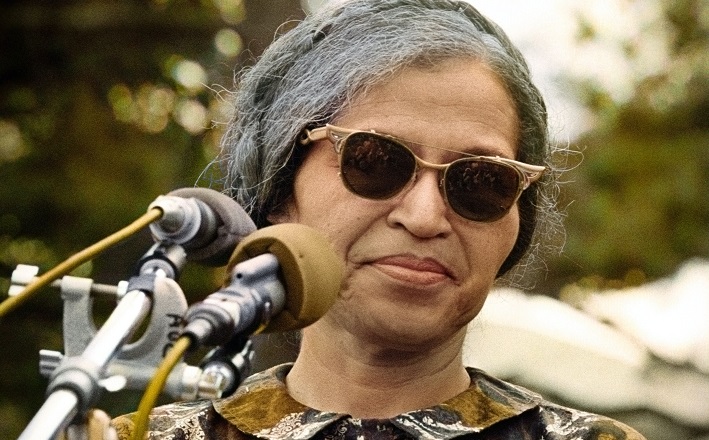Commentary on Mark 1:1-8
On August 1, 2020, the Sarah K. Evans Plaza opened in Roanoke Rapids, North Carolina.1
Evans, known formerly as Private Evans, is now 91 years old, and reflects on the seemingly unremarkable event that has led to public recognition almost 70 years later. In 1952 Private Evans was on her way home from her first military assignment, when she refused to move to the back of the bus. Upon refusing, she was taken to jail and detained for 13 hours. Evans sued the Interstate Commerce Commission for discrimination. Despite a judicial victory in November of 1955, the ruling was not enforced until 1961.
Meanwhile, in March of 1955, a young black teenager, Claudette Colvin, refused to give up her bus seat to a white person. Having been exposed to the actions of Sojourner Truth and Harriet Tubman, Colvin was emboldened to resist the injustice she experienced on the city bus. As a result, she was handcuffed and arrested. And like Evans, her story was hidden until recent years.
Before there was a Rosa Parks, the Civil Rights icon attributed with prompting the Montgomery Bus Boycott of 1955, there was Sarah Evans and Claudette Colvin. These trailblazing young women set in motion that which would be later attributed to Parks. Their names are scarcely, if at all, associated with the Civil Rights Movement, yet their actions precipitated one of the most pivotal events of the time. Evans preceded Colvin who preceded Parks. Just as John preceded Jesus.
Forerunners are often unseen figures and unsung heroes. Their back stories are unknown. The details of their lives are underimagined or undervalued. They garner minimal attention, because they are forerunners—those who plow the ground, destabilize the terrain, and make ready for change that is to come. They are not The One; they are those who come before The One. Every movement needs those who function as the advance team, that is, those who prepare the way for something beyond the present state of affairs. In today’s reading we find John preparing the way for Jesus. One homiletical entry for this text is to emphasize the necessity of those who are antecedents of change, setting the stage for an alternative future.
Forerunners and fortitude
Now visualize listening to the words of Mark 1 rather than reading the written record. This was the case for the First Century audience, practitioners of oral traditions and storytelling.2 It would be akin to a dramatic reading or interpretation that goes far beyond “a babe in a manger” and a weary Mary and Joseph. At the sound of lights, cameras, action, the author of Mark sets the fast-paced tone of the entire book in the first verse—Good News, Jesus Christ, Son of God. Sans the extensive genealogies provided by Matthew and Luke, and the intense Christological entrance to John’s gospel, Mark gives the listener a functionally focused title (rather than introduction), mirroring the rapid-fire record of Jesus’ life that is to follow.
Quickly the listener is moved from Jesus to John, as the writer echoes prophetic proclamations from the Hebrew scriptures: ‘the voice of a messenger, crying in the wilderness, preparing the way’ (1:2, 3).3 A glimpse into the synoptic gospels lets the 21st-century reader know that the lives of Jesus and John run parallel, at least until John is beheaded.4 John the Baptizer’s tragic end reminds us that the journey of forerunners is not without risk and consequence. Like John, Evans, Colvin, and Parks were imprisoned and ridiculed for what they believed was right. In the same way that John called early believers to repentance and suffered for his message, Evans and Colvin called communities to equity and just practices and suffered for their message. Even today, those who dare to defy the status quo and speak truth to power, even naming what can be before it is realized, experience threat, peril, and endangerment. Yet with fortitude, forerunners persevere. But wait, back to the visual scene of John’s life.
Forerunners and faith
In this Advent text John enters center stage, reminiscent of Elijah.5 Clothed in camel’s hair and leather, with a plate of locusts and honey nearby for a later meal, John’s life speaks of One who is to come. The scene is set in the wilderness. The most common reference to wilderness in the Hebrew Scriptures is to Mount Sinai, and is where the Israelites wandered for 40 years. Eerdmann’s Bible Dictionary suggests the wilderness was a place not meant for human habitation.6 It was considered the natural habitation of demons. In traditional interpretations the wilderness is depicted as a daunting place full of menacing sounds. As such, the wilderness was a place to be conquered and defeated.
However, theologian Delores Williams offers a different version of the wilderness, one rooted in the experiences of enslaved persons and that remains present in the traditions of many American Black churches. Rather than a place to be feared, Williams reinterprets wilderness through the lens of the biblical Hagar: wilderness is a place of struggle and Spirit, both problematic and promising. For in the wilderness, Hagar meets God. Hagar’s experiences become symbolic of the African American experience of wilderness as both sacred and struggle-ridden. “For African American slaves,” writes Williams, “the wilderness did not bear the negative connotations that mainline white pioneer culture assigned to it.” Further, “The wilderness was a positive place conducive to uplifting the spirit and to strengthening religious life.”7
The symbolic wilderness Williams describes enables us to hear the sounds of ancestors who navigated difficult terrain, preparing the way for generations to come. Forerunners. Perhaps understanding wilderness as a space where faith is cultivated and strengthened illuminates why “all the people of Jerusalem” went to John in the wilderness (1:5). They were drawn to a man on the margins with a message.
In this text, may we hear and see the value of those who pave the way – the way to Jesus and the way to liberation in this present life. May we reflect upon the contributions of those who made ways for us when there seemed to be no way. How might we better see them, support them, and appreciate them? Are there those among us who are blazing trails? May we pause in gratitude for their sacrifices and for the work they do in the wilderness. Regardless.
Notes
- “Sarah K. Evans Inclusive Public Art Project,” accessed August 20, 2020, http://sarahkevansproject.com/.
- Carol A. Newsom, Sharon H. Ringe, and Jacqueline E. Lapsley, eds., Women’s Bible Commentary, Third Edition: Revised and Updated, (Louisville, Ky: Westminster John Knox Press, 2012).
- See Malachi 3:1 and Isaiah 40:3
- See Mark 6:27.
- See 2 Kings 1:8.
- David Noel Freedman, ed., Eerdmans Dictionary of the Bible, (Grand Rapids, Mich: Eerdmans, 2000).
- Delores S. Williams, Sisters in the Wilderness: The Challenge of Womanist God-Talk, (Maryknoll, New York: Orbis, 2013).


December 6, 2020